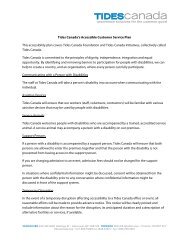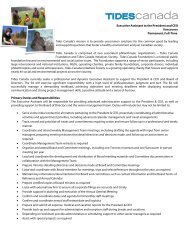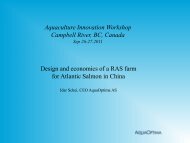Growing OpportunitySurvey Findings22Figure 2.5Manner of fundingCurrent N=92Expected in five years N=99%100908070605040302010No grants / Completely other incomeSome grants / Primarily other income59www.acumenfund.orgPrimarily grants / Some other incomeCompletely grants / No other incomeHow will funding patterns change overthe next 5 years?One of most striking findings was theremarkable collapse in the number ofentrepreneurs expecting <strong>to</strong> be relyingcompletely on grants in five years —from 27% <strong>to</strong> 8%. On the other side of theequation, there is an equivalent jump inthose expecting <strong>to</strong> be funding their ownoperations, with no reliance on grants —up from 8% <strong>to</strong> 28%. In the middle ground,we see a somewhat less dramatic fall in theproportion of respondents saying that theyexpect <strong>to</strong> be still relying on grants, but withsome income — 27% <strong>to</strong> 22% — and a morestriking growth in the proportion expectinga significant rebalancing in favor of earnedincome — from 38% <strong>to</strong> 50%.What are the main organizationaldevelopment challenges?‘Social entrepreneurship is still seen bysome as a “niche market”,’ said JacquelineNovogratz, CEO of Acumen Fund, 59‘comprised of a rather unique sort ofindividual who feels comfortable straddlingbusiness and social incentives. There arethus three main challenges around whetherand how it will move along the adoptioncurve and be accepted by a much largerclient base (translated in<strong>to</strong> funders andfoundations). First, the circle of visiblesocial entrepreneurs needs <strong>to</strong> be expandedsignificantly so that experts are not alwayspointing <strong>to</strong> the same examples of success.Second, there need <strong>to</strong> be more socialenterprises demonstrating scale in termsboth of the number of people they reachas well as the number they impactindirectly — and this means better measures<strong>to</strong> communicate quantitative as well asqualitative impact. Finally, there need <strong>to</strong> bemore enterprises moving <strong>to</strong>ward financialsustainability — or at least having plansthat demonstrate they will be around in thelong-term. Associated with this is whetherfunders will be able <strong>to</strong> “exit” successfully,but this is more derivative of the last point.’For our sample as a whole, theoverwhelming challenge flagged up inrelation <strong>to</strong> developing their organizationshad <strong>to</strong> do with people and talent. Specificpoints raised included the following:Attracting talent when they can’t offercompetitive salaries was cited by manyorganizations as a key developmentchallenge. But, while the dominantsentiment, it wasn’t universal. Someorganizations cited high retention rateseven though they offered lower thanmarket salaries. They believe that this is due<strong>to</strong> their ability <strong>to</strong> offer a work environmentthat is challenging (including professionalgrowth, learning opportunities), enablingtheir staff <strong>to</strong> focus on using their highestand best value skill sets (bringing in lowerskilled labor <strong>to</strong> do less fulfilling work), andproviding a culture that is mission-driven.A key advantage of the ability <strong>to</strong> retainand develop staff is that an organizationkeeps the tacit knowledge they have builtup of the field and players.Balancing entrepreneurialism withprofessionalism and maintaining a focuson the mission and culture of theorganization. As social enterprises mature,they require more professional andbusiness-oriented talent. But this poseschallenges in at least two ways. First,existing staff may find it difficult <strong>to</strong> adapt<strong>to</strong> the changing environment, when theirgeneralist skills are no longer sufficient.Second, new staff that bring moreprofessional capabilities may not havethe highest degree of sensitivity aroundthe mission. Also, not everyone in anorganization can or should be entrepreneurial;social enterprises struggle<strong>to</strong> find the right balance between thosewho should be creative and entrepreneurialand those (think lawyers and accountants)who need <strong>to</strong> support the entrepreneurialculture with more professional andstructured approaches. Those entrepreneurswho appear <strong>to</strong> be getting it right arevery focused on these elements duringthe recruiting process, foster a culture ofentrepreneurship through s<strong>to</strong>rytelling inthe organization, and make quick decisionsabout letting people go who don’t fit thedesired culture.Succession planning/leadershipdevelopment. Many entrepreneurscited challenges around grooming theirsuccessors, in particular around findingtalent that shared their vision forgrowth/success of the organization.At the extreme, there were two fascinatingresponses from Afghanistan that <strong>to</strong>uchedon this issue of drawing talent from apool of people that have been beatendown by war for nearly 30 years.
Growing Opportunity2360See Buried Treasure: Uncoveringthe Business Case for CorporateSustainability, SustainAbility and UNEP,2001; and Developing Value: The BusinessCase for Sustainability in EmergingMarkets, SustainAbility, the InternationalFinance Corporation (IFC) and Institu<strong>to</strong>Ethos, 2002. A ‘Developing Value 2’ projectis now under way.61For more, see the work of scenarioplanners Pierre Wack and Peter Schwartz.3 The Business CaseTo have any chance of changing theworld, entrepreneurial solutions mus<strong>to</strong>ffer relatively high leverage, be able <strong>to</strong>replicate and scale, and — fundamentally— become part of the market mainstream.Pretty much without exception,the social entrepreneurs we interviewedwere supportive of the idea of partnershipswith corporations. They were alsointerested <strong>to</strong> further develop thosepartnerships they already had, and <strong>to</strong>develop more.But, why should business care?SustainAbility has covered the businesscase for corporate responsibility andsustainability elsewhere, 60 so what followsis a headlines-only brief.It’s time <strong>to</strong> think differentThe first reason that business needs <strong>to</strong>engage is that the world is changing — andwith it markets. Social and environmentalentrepreneurs do not have all the answers,but they do see the world and marketsdifferently, and the more innovative areexperimenting with new business modelsthat could potentially break out of theirniches and help transform key elementsof the global economy.There is a real risk that many businesspeople will chalk this up as anotherfluffy, feel-good fad. There is every reason<strong>to</strong> be skeptical of any new movement oragenda, clearly, but our industry analyses(summarized in Chapters 4 and 5)uncovered a variety of ways that socialentrepreneurs are doing things differently,realizing exciting sustainability outcomesand offering innovative opportunities forbusiness.Just as software morphs through successivegenerations, 1.0, 2.0 and so on, weconclude that the time has come forwhat we call 3.0 thinking in relation <strong>to</strong>sustainability challenges. If 1.0 was drivenby regula<strong>to</strong>rs and promoted a compliancemindset in business, 2.0 has been moreabout corporate citizenship, based ontransparency, accountability and a growingarray of voluntary initiatives (Figure 3.1).By contrast, 3.0 thinking, strategy andventures is different in that it seekstransformative market and sustainabilityoutcomes. It is about creative destruction,as Joseph Schumpeter called it, and aboutcreative reconstruction.In essence, Mindset 3.0 is about seeing —‘reperceiving’ 61 — immense challenges,such as the growing risk of abrupt climatechange, as potential opportunities <strong>to</strong>leverage the power of markets and business<strong>to</strong> reboot entire economic and politicalsystems. This is exactly what is beginning<strong>to</strong> happen in the energy field. In somecases the time-scales involved may begenerational, but the transformation isunder way. While the cleantech landscapeis now largely populated with pure-playprofit seekers, the industry was pioneeredby individuals who saw the opportunity <strong>to</strong>leverage market drivers — such as energysecurity, stability, and cost — <strong>to</strong> realizesignificant environmental outcomes.The situation is different in the developingcountry healthcare field, where pulling onmarket levers does not work in the sameway, largely due <strong>to</strong> weak end-markets.But the overwhelming unmet need forgood, well-funded, state-provided healthcaresystems has not prevented socialentrepreneurs from experimenting withcross-subsidized business models (richpatients’ fees covering the costs of thepoor, large companies’ assets and talentsbeing loaned for health outcomes).Though their efforts often expose the limitsof current market-based social enterpriseapproaches in areas like poverty, theyare spotlighting potential new markets,experimenting with new business modelsand modeling new leadership approaches.
















